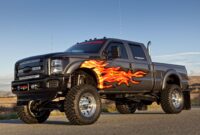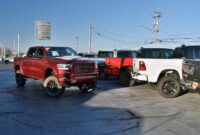Narrow Aisle Reach Truck: Maximizing Space and Efficiency in Modern Warehouses cars.truckstrend.com
In the dynamic world of logistics and supply chain management, every square foot of warehouse space is a valuable asset. As demand for faster fulfillment and higher storage density continues to surge, businesses are constantly seeking innovative solutions to optimize their operations. Enter the Narrow Aisle Reach Truck – a specialized piece of material handling equipment that has become indispensable for warehouses looking to maximize vertical storage and streamline workflows in confined spaces.
Far from being just another forklift, the narrow aisle reach truck is a precision instrument designed for high-density storage. Its unique design allows it to operate effectively in aisles significantly narrower than those required by traditional counterbalance forklifts, often reducing aisle widths by 30-50%. This remarkable capability translates directly into increased storage capacity, lower building costs, and enhanced operational efficiency, making it a cornerstone of modern, space-optimized warehousing.
Narrow Aisle Reach Truck: Maximizing Space and Efficiency in Modern Warehouses
What is a Narrow Aisle Reach Truck?
A narrow aisle reach truck, often simply called a "reach truck," is an electric-powered forklift specifically engineered for high-density storage applications. Unlike traditional forklifts where the forks are fixed at the front, a reach truck features a mast that can "reach" forward (hence the name) to pick up or deposit loads. This mechanism allows the truck to remain within the aisle while accessing pallets from deep within the racking system.
Key characteristics that define a reach truck include:
- Compact Chassis: Designed to navigate extremely narrow aisles, typically ranging from 8 to 11 feet (2.4 to 3.3 meters), depending on the model and load size.
- Telescoping Mast with Reach Mechanism: The core differentiating feature. The mast, along with the forks, extends horizontally to pick up or place loads, and then retracts, keeping the load within the truck’s footprint for stability during travel. This mechanism is usually either a pantograph (scissor-like extension) or a moving mast (the entire mast slides forward).
- Stand-Up Operation: Most reach trucks are designed for stand-up operation, providing operators with excellent visibility and ergonomic benefits, especially during frequent ingress and egress.
- High Lifting Capabilities: Capable of lifting loads to significant heights, often exceeding 30 feet (9 meters), allowing warehouses to utilize vertical space effectively.
- Electric Powered: Primarily battery-operated, offering quiet, emission-free operation suitable for indoor environments.

The Unparalleled Benefits of Narrow Aisle Reach Trucks
The adoption of narrow aisle reach trucks offers a multitude of advantages that directly impact a warehouse’s bottom line and operational efficiency:
Space Optimization

This is the most significant benefit. By dramatically reducing the required aisle width, reach trucks enable warehouses to install more racking and store a higher volume of goods within the same footprint. This can lead to a 30-50% increase in storage capacity, deferring the need for costly new construction or expansion.
Increased Productivity
Their agility and ability to operate in confined spaces mean faster travel times within aisles and quicker pallet retrieval and put-away. The precise controls and excellent visibility enhance the speed and accuracy of operations, leading to higher throughput.
Enhanced Safety
While operating in narrow aisles requires skill, reach trucks often contribute to a safer environment. Their compact design reduces the risk of collisions with racking or other equipment. Enhanced visibility from the stand-up position, coupled with modern safety features like operator presence sensors, automatic braking, and optional cameras, further improves operational safety.

Versatility
Reach trucks are highly versatile, capable of handling a wide range of palletized and non-palletized loads. Their precision makes them ideal for fragile items, while their robust construction allows for heavy-duty tasks. Being electrically powered, they are perfect for indoor use where air quality is a concern.
Cost Efficiency
Beyond the immediate space savings, reach trucks offer long-term cost benefits. Reduced travel distances within the warehouse can lower energy consumption. Electric power means lower fuel costs and reduced maintenance compared to internal combustion forklifts. The ability to maximize existing space also reduces the overall cost per square foot of storage.
Key Features and Technology
Modern narrow aisle reach trucks are equipped with advanced features designed to maximize performance, safety, and operator comfort:
- Reach Mechanism Types:
- Pantograph Reach Trucks: Utilize a scissor-like mechanism to extend the forks forward. They are generally compact and excellent for high-density storage.
- Moving Mast Reach Trucks: The entire mast assembly moves forward and backward. These often offer higher residual capacities at extreme lift heights and can be more stable with very heavy loads.
- Lift Height and Capacity: Models vary widely, offering lift heights from 20 feet up to 45 feet (6 to 14 meters) and capacities typically ranging from 2,500 to 4,500 lbs (1,130 to 2,040 kg). Selection depends on the specific warehouse requirements.
- Operator Ergonomics: Stand-up cabins are designed for comfort during long shifts, featuring cushioned floors, adjustable controls, and clear sightlines. Ergonomic controls reduce operator fatigue and increase precision.
- Power Source: Primarily lead-acid or lithium-ion batteries. Lithium-ion batteries are gaining popularity due to faster charging times, longer runtimes, and reduced maintenance.
- Advanced Safety Features: Include load weight indicators, mast height indicators, automatic speed reduction in turns, stability control systems, operator presence sensors, blue spot lights (to warn pedestrians), and integrated cameras for precise load placement at height.
- Telematics and Connectivity: Many modern reach trucks come with telematics systems that provide real-time data on usage, battery life, impact detection, and maintenance needs, enabling better fleet management and operational insights.
Choosing the Right Narrow Aisle Reach Truck
Selecting the optimal reach truck for your operation requires careful consideration of several factors:
- Warehouse Layout: Crucial elements include minimum aisle width, maximum rack height, and floor condition. Uneven floors can impact stability and require specific tire types.
- Load Characteristics: Analyze the typical weight, dimensions, and stability of the loads you’ll be handling. This determines the required lift capacity and mast type.
- Throughput Requirements: Consider the volume of pallets moved per hour or shift. This impacts the necessary travel speed, lift speed, and battery capacity.
- Operator Comfort and Training: A comfortable operator is a productive and safe operator. Invest in models with good ergonomics and, critically, ensure comprehensive training and certification for all operators.
- Budget and Return on Investment (ROI): While the initial investment can be higher than traditional forklifts, calculate the long-term ROI based on increased storage capacity, reduced operational costs, and improved productivity. Consider leasing options as an alternative to outright purchase.
- Maintenance and Support: Evaluate the availability of spare parts, service technicians, and warranty support from the manufacturer or dealer.
Operational Best Practices and Safety Tips
Operating a narrow aisle reach truck safely and efficiently requires adherence to best practices:
- Comprehensive Operator Training: Mandatory and ongoing. Operators must be certified and familiar with the specific model’s controls, load capacities, and emergency procedures.
- Pre-Operation Checks: Daily inspection of brakes, tires, lights, horn, battery level, and hydraulic systems. Report any defects immediately.
- Proper Load Handling: Ensure loads are stable, correctly centered on the forks, and within the truck’s rated capacity. Never exceed load limits. Maintain clear visibility by not overloading or obstructing the view.
- Aisle Etiquette: Always adhere to speed limits within aisles. Be aware of pedestrians and other equipment. Use the horn at intersections or blind spots.
- Battery Management: Follow manufacturer guidelines for charging and maintenance of batteries to maximize their lifespan and ensure consistent power.
- Regular Maintenance Schedule: Implement a preventive maintenance program to keep the truck in optimal working condition, preventing breakdowns and ensuring safety.
Challenges and Solutions
While highly beneficial, narrow aisle reach trucks do present certain considerations:
- Initial Investment Cost: Reach trucks can have a higher upfront cost compared to some other material handling equipment.
- Solution: Focus on the long-term ROI through increased storage density and operational efficiency. Explore leasing or financing options to manage capital expenditure.
- Operator Skill Requirement: Operating a reach truck, especially at height in narrow aisles, requires a higher level of skill and precision.
- Solution: Invest in thorough, certified training programs for operators. Implement ongoing refresher courses and performance monitoring.
- Floor Condition Sensitivity: Uneven or damaged floors can impact the stability and smooth operation of reach trucks, especially with high lifts.
- Solution: Regular floor maintenance and repair are crucial. Consider industrial-grade flooring solutions in high-traffic areas.
- Battery Life and Charging Downtime: Electric trucks require charging, which can lead to downtime if not managed properly.
- Solution: Implement multi-battery systems (swap-out batteries), fast chargers, or opportunity charging strategies (charging during breaks) to minimize downtime. Lithium-ion batteries offer faster charging and longer runtimes.
Practical Advice and Actionable Insights
Before making a significant investment, conduct a detailed warehouse audit. Measure your current storage capacity, aisle widths, and potential for vertical expansion. Calculate the potential increase in storage density and the corresponding reduction in per-pallet storage costs that a reach truck can offer. Prioritize operator training and ongoing safety protocols, as a well-trained workforce is the greatest asset. Finally, always consider the total cost of ownership (TCO), including maintenance, energy consumption, and expected lifespan, rather than just the initial purchase price.
Concluding Summary
The narrow aisle reach truck stands as a testament to innovation in material handling, offering an unparalleled solution for optimizing warehouse space and enhancing operational efficiency. By enabling businesses to store more in less space, these powerful machines not only reduce overheads but also significantly boost productivity and safety in high-density storage environments. Investing in the right narrow aisle reach truck is a strategic decision that positions a warehouse for future growth, making it a truly indispensable asset in the modern logistical landscape.
Price Table: Narrow Aisle Reach Truck (Estimated Ranges)
Please note: These prices are estimates and can vary significantly based on brand (e.g., Crown, Raymond, Toyota, Hyster, Yale), specific model, lift height, capacity, features (e.g., telematics, camera systems, specialized forks), battery type (lead-acid vs. lithium-ion), geographical location, dealer incentives, and market conditions. Leasing options are also widely available.
| Category | Lift Height (ft) | Capacity (lbs) | Key Features | Estimated New Price Range (USD) | Estimated Used Price Range (USD) |
|---|---|---|---|---|---|
| Entry-Level | 20-25 | 2,500-3,000 | Basic controls, Lead-acid battery | $35,000 – $55,000 | $15,000 – $30,000 |
| Mid-Range | 25-35 | 3,000-3,500 | Ergonomic cabin, AC motors, basic telematics, Lead-acid/Li-ion option | $55,000 – $75,000 | $30,000 – $45,000 |
| High-Performance | 35-45+ | 3,500-4,500+ | Advanced controls, Li-ion battery, advanced telematics, cameras, stability systems | $75,000 – $100,000+ | $45,000 – $70,000+ |
Note: Prices do not typically include additional attachments, specialized charging infrastructure, or long-term maintenance contracts, which would add to the overall cost.
Frequently Asked Questions (FAQ)
Q1: What’s the main difference between a reach truck and a standard counterbalance forklift?
A1: The primary difference is how they handle loads and operate in aisles. A standard counterbalance forklift carries the load in front of the front wheels and requires wider aisles for maneuvering. A reach truck’s mast extends forward to pick up a load, then retracts it back within the truck’s footprint, allowing it to operate in significantly narrower aisles (often 8-11 feet compared to 12-14 feet for counterbalance). Reach trucks are also typically stand-up and electric-powered for indoor use.
Q2: How narrow can an aisle be for a narrow aisle reach truck?
A2: The minimum aisle width depends on the specific model of the reach truck and the dimensions of the loads being handled. Generally, narrow aisle reach trucks can operate in aisles as narrow as 8 to 11 feet (2.4 to 3.3 meters). This is significantly narrower than the 12 to 14 feet required for standard counterbalance forklifts.
Q3: Are reach trucks difficult to operate?
A3: Reach trucks require a higher degree of skill and precision than some other types of forklifts, especially when operating at high lift heights in confined spaces. Comprehensive training and certification are essential for safe and efficient operation. However, with proper training, operators can quickly become proficient.
Q4: How high can a narrow aisle reach truck lift?
A4: Most narrow aisle reach trucks can lift loads to impressive heights, typically ranging from 20 feet (6 meters) for entry-level models up to 45 feet (14 meters) or even higher for specialized high-performance models. This capability is crucial for maximizing vertical storage space.
Q5: What’s the typical lifespan of a reach truck?
A5: The lifespan of a narrow aisle reach truck can vary widely depending on usage intensity, maintenance practices, and environmental conditions. With proper maintenance, a well-built reach truck can last 10,000 to 15,000 hours of operation or more, which often translates to 10-15 years in a typical warehouse setting.
Q6: Are narrow aisle reach trucks electric or fuel-powered?
A6: Narrow aisle reach trucks are almost exclusively electric-powered. They run on large industrial batteries (either lead-acid or lithium-ion). This makes them ideal for indoor use as they produce zero emissions and operate quietly.
Q7: What safety features do modern reach trucks have?
A7: Modern reach trucks are equipped with numerous safety features, including: operator presence detection (truck won’t operate without an operator in position), automatic speed reduction in turns, stability control systems, load weight indicators, mast height indicators, blue spot lights (to alert pedestrians), and optional features like integrated cameras for precise load placement at height, and telematics systems for impact monitoring.
Q8: Can narrow aisle reach trucks be used outdoors?
A8: Narrow aisle reach trucks are primarily designed for indoor use on smooth, level concrete floors. While some might be able to handle very limited outdoor use on paved surfaces, they are not built for rough terrain or prolonged exposure to outdoor elements like rain or extreme temperatures, which can damage their electrical components and impact stability.



